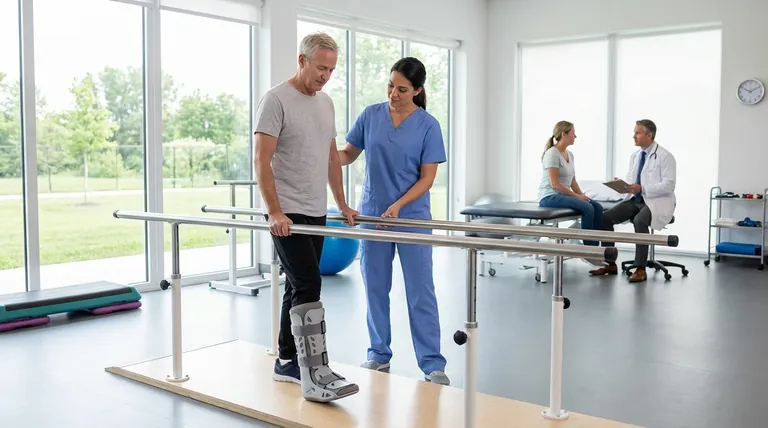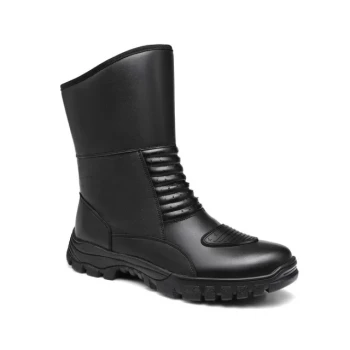At its core, a walking boot is a medical device designed to protect and stabilize your foot and ankle after an injury or surgery. It works by restricting harmful movements and managing weight-bearing pressure, which allows the injured area to heal properly while still permitting you to maintain a degree of mobility.
The fundamental purpose of a walking boot is to resolve the conflict between two essential needs: the need for immobility to heal an injury and the need for mobility to function in daily life. It provides a controlled environment for recovery.

How a Walking Boot Accelerates Healing
A medical boot is more than just footwear; it is an engineered tool that creates the optimal conditions for your body to repair itself.
By Providing Rigid Support and Stability
The boot acts as an external skeleton for your lower leg, foot, and ankle. This rigid structure secures the injured bones, ligaments, or tendons in a stable position.
This immobilization is critical for preventing motions that could disrupt the healing process or cause additional damage.
By Controlling Weight-Bearing Pressure
Unlike a traditional cast that may require crutches for non-weight-bearing, a walking boot is designed to allow safe, limited weight on the injured limb.
Its "rocker" sole helps you roll through a step naturally, redistributing pressure across the bottom of your foot and away from the specific injury site.
By Enabling Safe Mobility
By providing stability and managing pressure, the boot allows you to walk and perform limited activities. This controlled movement can help prevent muscle atrophy and stiffness associated with complete immobilization.
Common Conditions That Require a Walking Boot
A healthcare provider will assess your specific injury, pain level, and instability to determine if a walking boot is the right course of action.
Fractures and Stress Fractures
For broken bones in the foot, ankle, or lower leg, a boot holds the fractured pieces in alignment so they can mend correctly.
Severe Sprains and Strains
When ligaments (sprains) or tendons (strains) are significantly torn or damaged, the boot protects these soft tissues from further stress.
Post-Surgical Recovery
Following surgery on the foot or ankle, a boot is essential for protecting the repaired area and ensuring the delicate surgical work is not compromised during the healing phase.
Tendon and Ligament Injuries
Conditions like severe tendonitis or torn tendons require the stability a boot provides to reduce inflammation and allow the tissue to repair without constant reinjury.
Understanding the Trade-offs and Responsibilities
While highly effective, using a walking boot comes with practical considerations for safety and care.
The Importance of Proper Fit
You must regularly check your foot for signs of excessive swelling or redness. If the boot feels too tight, the straps may need to be loosened to avoid circulation issues.
The Risk on Wet Surfaces
The sole of a walking boot can be slippery, especially on wet or slick floors. You must exercise extra caution to prevent a fall that could worsen your injury.
Following Medical Advice
Your doctor will provide specific instructions on when you can and cannot remove the boot. This guidance, especially regarding bathing or sleeping, is crucial for a successful recovery.
Maintaining Hygiene
The boot's liner can be hand-washed with mild soap and must be completely dry before re-use to prevent skin irritation. The plastic components can be wiped clean with a damp cloth.
Making the Right Choice for Your Recovery
Using your walking boot correctly is an active part of your healing process. Your approach should align with your specific injury.
- If your primary focus is healing a fracture: The boot's most critical function is immobilizing the bone, allowing it to mend without disruption from movement.
- If your primary focus is recovering from a severe sprain: The boot protects the damaged soft tissues from re-injury while allowing the controlled stress needed for them to heal stronger.
- If your primary focus is post-surgical care: Adhering strictly to your surgeon's instructions for wearing the boot is essential to protect the surgical site and ensure a successful outcome.
Ultimately, a walking boot is a tool that empowers you to participate actively and safely in your own recovery.
Summary Table:
| Function | Benefit |
|---|---|
| Rigid Support & Stability | Immobilizes the injury to prevent further damage. |
| Controlled Weight-Bearing | Allows safe walking with a rocker sole to redistribute pressure. |
| Enables Safe Mobility | Helps prevent muscle atrophy and stiffness during recovery. |
| Common Uses | Fractures, severe sprains, post-surgery, and tendon injuries. |
Need a reliable supply of medical walking boots?
As a large-scale manufacturer, 3515 produces a comprehensive range of high-quality medical and protective footwear for distributors, brand owners, and bulk clients. Our production capabilities ensure durable, effective walking boots that support patient recovery.
Contact us today to discuss your sourcing needs and discover how we can be your trusted manufacturing partner.
Visual Guide

Related Products
- Premium Grain Leather Safety Boots for Bulk Supply
- Customizable Anti-Smash Safety Boots for Wholesale & Private Label Manufacturing
- Custom Wholesale Leather Safety Boots Direct Factory Manufacturing
- Premium Wholesale Wheat Nubuck Safety Boot with Rapid Lacing System
- High Performance Fire-Retardant Waterproof Safety Boots
People Also Ask
- Is there a downside to steel toe boots? Weighing Protection Against Daily Comfort
- Is safety-toe as good as steel toe? Choose the Right Protection for Your Job
- What boots do they wear on oil rigs? Essential Safety Footwear for Harsh Conditions
- What is the OSHA standard for safety-toe boots? Ensuring Compliance and Worker Protection
- Is safety toe better than steel toe? A Guide to Choosing the Right Protection



















